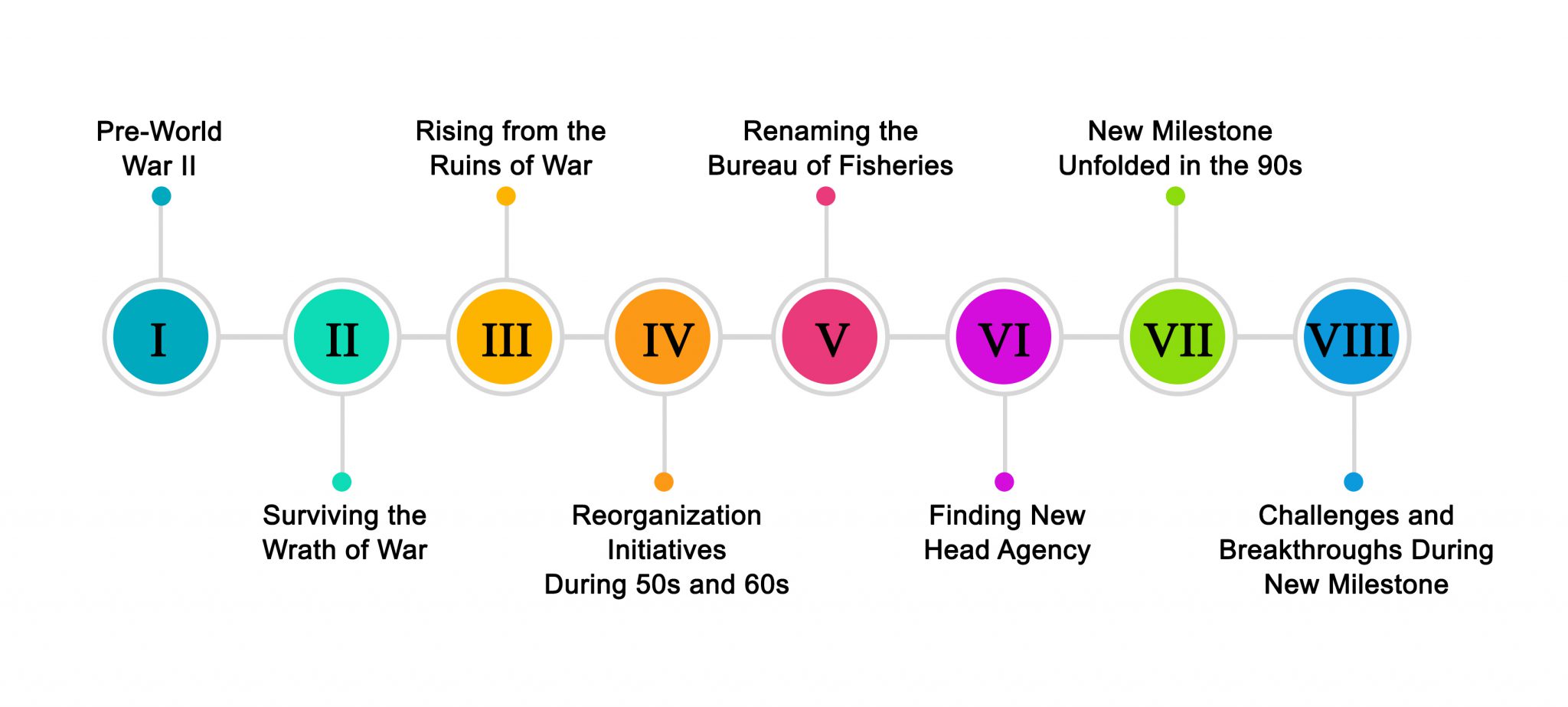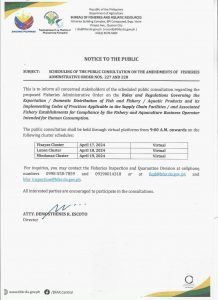
When the Civil Government was established on July 4, 1901, the Philippine Commission proposed the creation of an Office under the Department of the Interior to take charge of the conservation, promotion and development of the country’s fishery resources. This was not carried out, due to limited funds. The Secretary of the Interior continued to stir interest in the development of fisheries. Finally, in 1907, studies in fisheries began following the arrangements made by the Secretary of the Interior for the services of the U.S. Fish Commission research fishing vessel “Albatross” to work in Philippine waters for eighteen months; and the employment of an American specialist in fisheries in the Bureau of Science to take charge of all work pertaining to fisheries. This Division remained under the Bureau of Science until the end of 1932.
On January 1, 1933, by virtue of General Memorandum Order No. 4, dated December 5, 1932, of the Secretary of Agriculture and Commerce, the Division of Fisheries and the Division of Zoology of the Bureau of Science, together with the Division of Forest Fauna and Grazing of the Bureau of Forestry, were fused into one special division known as the Fish and Game Administration, which was placed under the direct administrative jurisdiction of the Department of Agriculture and Commerce. Under this arrangement, the Fish and Game Administration operated under the provisions of the Fisheries Act (Act No. 4003) and Act No. 2590, entitled “An Act for the Protection of Game and Fish.” By subsequent reorganization effected on September 27, 1934, the Fish and Game Administration was returned to the Bureau of Science. The reason for its return was to strengthen the office through the use of equipment, personnel, and appropriation of the said Bureau.
On July 1, 1939, under the provisions of General Administrative Order No. 15, the Fish and Game Administration was reorganized as an independent unit under the Department of Agriculture and Commerce and renamed Division of Fisheries. The functions pertaining to forest fauna and grazing were returned to the Bureau of Forestry and those of the Division of Zoology to the Bureau of Science.
The Division of Fisheries, as a special division under the Department of Agriculture and Commerce, functioned until the outbreak of the war in 1941. During the early days of World War II, the Division of Fisheries was fused with the Bureau of Forestry and then known as the Bureau of Forestry and Fishery. In the latter part of the enemy occupation, however, the Division of Fisheries was converted into an independent office known as the Bureau of Fisheries.
Three years after liberation from the enemy’s occupation, the Congress of the Philippines, cognizant of the improtance of fisheries and aquatic resources conservation to the rehabilitation of the country’s prostate economy brought about the war, enacted Republic Act No. 177 creating the Bureau of Fisheries which took effect on 1st of July 1947. The former Division of Fisheries and its sections, field districts, and experimental stations including all fisher-related activities of national government agencies were integrated in the Bureau of Fisheries.
When it was founded in 1947, the Bureau of Fisheries had seven functional divisions, namely, (1) Administrative Division; (2) Fish Culture and Fisheries Biology; (3) Division of Commercial Fisheries; (4) Division of Fisheries Technology; (5) Division of Licenses and Regulations; (6) Division of Investigation and Inspection; and (7) Philippine Institute of Fisheries Technology offering a two and half college course in fisheries. Subsequently, branches of this institute offering a 4-year secondary course in fisheries were established in Samar, Cebu, Albay, Iloilo, Zamboanga City, Antique and Batangas.
Following the same organization effort, the entire Philippines divided into ten fishery districts, each with a District Fishery Officer as head. The headquarters of the ten (10) fishery district where located in strategic places in the different fishing regions: Fishery District No. 1-Aparri, Cagayan; 2-Dagupan City; 3-Manila; 4-Naga City; 5-Catbalogan, Samar; 6-Iloilo City; 7-Coron, Palawan; 8-Cebu City; 9-Davao City; and10-Zamboanga City.
The establishment of the Bureau of Fisheries on 1 July 1947 has been considered as the official foundation day of the organization which is being celebrated every year up to this day.
Executive Order No. 216, dated 17 November 1956 implemented Reorganization Plan No. 30-A reorganizing the Department of Agriculture and Natural Resources. Following this event, the Bureau of Fisheries which was reorganized on 16 January 1957, almost a decade after after its creation. With this reorganization, functional divisions of the Bureau had been reduced from seven to five, namely: 1) Licenses and Regulations Division; (2) Marine Fisheries Division; (3) Fisheries Research Division; (4) Inland Fisheries Division; and (5) Administrative Services Division.
The Philippine Institute of Fisheries Technology had been tranbsferred to the University of the Philippines. The seven secondary schools of fisheries in the provinces previously mentioned had been transferred to the Department of Education under the administration of the Bureau of Public Schools. On 20 March 1963, R.A. 3512 reorganized the Bureau of Fisheries and became the Philippine Fisheries Commission. In summary, the government fisheries agency had undergone three reorganization efforts during the 50s and the 60s.
At the dawn of the new decade during th 70s, a new reorganization initiative was introduced. On 20 September 1972, under the Integrated Reorganization Plan, th Philippine Fisheries Commission wa reverted to the Bureua of Fisheries. Two years thereafter, by virtue of Presedential Decree No. 461 signed on 17 May 1974which reorganized the Department of Agriculture and the Department of Natural Resources, the agency was renamed as Bureau of Fisheries and Aquatic Resources of 1975 otherwise known as P.D. 707 where all fishery legislations had condified into. It ushered in a new era for Philippine fisheries where it encouraged the maximum utilization of the fisheries reources in an integrated manner while putting limits to fishing by reserving the seven kilometer zone to small-scale fisherfolk.
The Bureau of Fisheries and Aquatic Resources remained with the Ministry of Natural Resouces for one decade until the agency was transferred to the jurisdiction of the Ministry of Agriculture and Food on 30 June 1984 in compliance with Executive Oreder No. 967 mandating the conversion of BFAR as a staff Bureau and integrating its Regional Offices with the Regional offices of the Department of Agriculture. The agency’s staff function and integration of its regional offices to the Department of Agriculture was fully implemented on 30 January 1987 with the issuance of Executive Order 116 signed by former President Corazon C. Aquino.
Consequently, after a series of reorganizations in 1997, BFAR’s services were delivered through the nine (9) functional divisions: the Fisheries Policy Research and Economics Division, Fishery Resources Administration Division, Fisheries Development and Support Services Division, Aquaculture Division, Fisheries Resources Research Division, EEZ Exclusive Economic Zone Fisheries and Allied Services Division, Fishing Technology Division, Fisheries Regulation and Quarantine Division, and Post-Harvest Technology Division. It also has eight (8) fisheries technology centers under its wing: The National Marine Fisheries Development Center, National Brackish Aquaculture Technology Research Center, National Freshwater Fisheries Technology Research Center, Tanay Freshwater Expirement Station, Fisheries Biological Station Complex, National Fisheries Research Development center,


